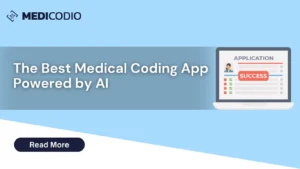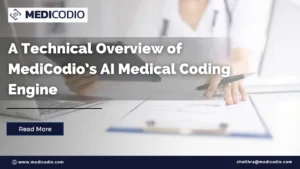The world of medical coding is undergoing a significant transformation driven by emerging technologies. Medical coding technologies such as MediCodio and others are taking this field to a whole new level. The traditional manual process of assigning standardized codes to diagnoses and procedures is being reshaped by automation and artificial intelligence, leading to a future of increased accuracy, efficiency, and cost-effectiveness.
Today, medical coding technologies have simplified and streamlined the process improving productivity and reimbursements.
In this article, let’s have a look at the 3 supporting pillars of medical coding space: Encoders, CAC, and AI medical coding tools.
Understanding the Codebreakers: Encoders
An encoder in healthcare is essentially a software tool designed to facilitate the selection of appropriate medical codes from a predefined set of terminologies. These codes are used for various purposes such as billing, record-keeping, and statistical analysis. The structure of an encoder typically resembles a tree, with general categories branching out into more specific ones, mirroring the hierarchical nature of medical classification systems.
This tree-like structure allows medical coders to choose medical codes until they find the most specific set of diagnosis and procedure codes available.
Encoders play a crucial role in healthcare for several reasons. Firstly, they significantly enhance the efficiency and accuracy of medical coding processes. By providing a structured framework and guiding users through the selection of codes, encoders help coders avoid errors and ensure consistency in coding practices. This, in turn, leads to more reliable medical records and billing information.
Secondly, encoders are instrumental in ensuring proper reimbursement for healthcare organizations. Accurate coding is essential for billing purposes, as it directly impacts the amount of reimbursement received from insurance companies or government healthcare programs. By assisting coders in selecting the most appropriate codes for each patient encounter, encoders help maximize reimbursement while minimizing the risk of denials or audits.
Additionally, encoders can contribute to patient safety efforts by facilitating the identification of avoidable safety events through the analysis of coded data. By flagging certain patterns or indicators, such as Patient Safety Indicators (PSIs), encoders enable healthcare providers to proactively address potential risks and improve the overall quality of patient care.
In comparison, Computer Assisted Coding (CAC) is used in healthcare to automate the coding process. While encoders primarily focus on providing a structured interface for manual coding tasks, CAC goes a step further by leveraging advanced algorithms and Natural Language Processing (NLP) techniques to automatically generate codes from clinical documentation.
In summary, while both encoders and Computer Assisted Coding systems serve similar purposes in healthcare, they differ in their approach and level of automation. Encoders provide a structured interface for manual coding tasks, enhancing efficiency and accuracy, while CAC systems automate the coding process using advanced algorithms and NLP techniques. Ultimately, both technologies play important roles in streamlining medical coding processes and improving healthcare outcomes.
A Helping Hand: Computer-Assisted Coding (CAC)
To alleviate the burden on encoders and enhance efficiency in the coding process, computer-assisted coding (CAC) software emerges as a valuable ally. CAC utilizes advanced algorithms to analyze medical records and suggest relevant codes automatically. By leveraging machine learning and natural language processing techniques, CAC can interpret clinical documentation and recommend appropriate codes based on context, syntax, and semantics.
While CAC streamlines routine coding tasks, it does not replace the human expertise of encoders. Instead, it serves as a complementary tool, augmenting their capabilities and improving productivity. By automating mundane coding activities, CAC enables encoders to focus their attention on more complex cases, such as ambiguous diagnoses or specialized medical procedures, where their expertise is indispensable.
Moreover, CAC promotes consistency and standardization in the coding process, reducing the likelihood of errors and discrepancies. It helps ensure adherence to coding guidelines and regulatory requirements, mitigating compliance risks for healthcare providers and payers. Additionally, advanced medical coding technologies like CAC facilitates workflow optimization by expediting coding turnaround times and reducing backlogs, thereby enhancing revenue cycle management and operational efficiency.
In essence, the symbiotic relationship between encoders and CAC exemplifies the synergy between human intelligence and technological innovation in the healthcare domain. While encoders bring domain knowledge and critical thinking skills to the table, CAC complements their efforts by harnessing the power of automation and data analytics. Together, they form a dynamic partnership that advances the accuracy, efficiency, and integrity of medical coding processes, ultimately contributing to improved patient care and outcomes.
The Power of AI: AI-Powered Medical Coding Technologies
Taking automation a step further, AI-powered medical coding tools utilize advanced machine learning algorithms. These intelligent medical coding technologies can learn from vast amounts of medical data to identify patterns, predict coding requirements with high accuracy, and even suggest the most appropriate codes for specific procedures. AI tools not only improve coding speed and accuracy but also help mitigate the risk of errors and omissions in claims submission.
Introducing MediCodio: Simplifying Medical Coding
MediCodio is on a mission to revolutionize medical coding by harnessing the power of cutting-edge AI technology. Their AI-powered coding tools empower RCM companies and healthcare facilities to achieve new levels of efficiency and accuracy. MediCodio’s innovative solutions streamline the coding process, reduce costs, and ensure timely reimbursements, allowing healthcare providers to focus on what matters most – delivering exceptional patient care.
By embracing these technologies, healthcare providers can empower their coding teams, optimize reimbursement, and ultimately enhance patient care.
While traditional methods still hold value, medical coding technologies are transforming the field. From automating tedious tasks to leveraging AI for intelligent code suggestions, these advancements promise a future of increased efficiency, accuracy, and cost-effectiveness. As medical coding technologies continue to develop, they have the potential to streamline healthcare processes for both providers and patients.
If you’re ready to see how medical coding technologies can revolutionize your practice, please schedule a demo today and discover how to unlock a new era of streamlined coding and financial success.





